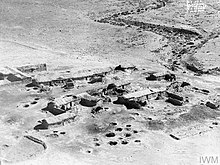
Back مذبحة سميل Arabic ܩܛܠܥܡܐ ܕܣܡܠܐ ARC کۆمەڵکوژیی سێمێل CKB Massaker von Semile German Masacre de Simele Spanish کشتار سمیل Persian Massacre de Simelé French טבח סימל HE Կոտորած Սեմմելում Armenian Pembantaian Simele ID
| Simele massacre | |
|---|---|
 Aerial view of Batarshah in northern Iraq, an Assyrian village destroyed by Arabs and Kurds in August 1933 | |
 Area where villages were looted
Heavily targeted Assyrian villages | |
| Native name | مذبحة سميل (Arabic)[1] ܦܪܲܡܬܵܐ ܕܣܸܡܹܠܹܐ (Syriac)[2][3] |
| Location | Northern Kingdom of Iraq, notably at Simele |
| Date | 7 August 1933 – 11 August 1933 |
Attack type | Summary executions, mass murder, looting |
| Deaths | Several hundred (British estimate)[4][5][6] 3,000–6,000 (Assyrian estimate) |
| Victim | Assyrians |
| Perpetrators | Royal Iraqi Army (led by Bakr Sidqi, Arab and Kurdish tribes[7] |
The Simele massacre (Arabic: مذبحة سميل, romanized: maḏbaḥat Simīl), also known as the Assyrian affair,[8] was committed by the Kingdom of Iraq, led by Bakr Sidqi, during a campaign systematically targeting the Assyrians in and around Simele in August 1933.
The number of deaths was estimated by British officials at 600.[5] Some Assyrian estimates are higher positing that as many as 6,000 were killed and over 100 Assyrian villages were destroyed and looted.[9][10]
- ^ "عضوة الكونغرس الامريكي جان شاكوسكي تصدر بيانا في ذكرى مذبحة سميل التي تعرض لها شعبنا عام 1933". Zowaa (in Arabic). 8 August 2020. Retrieved 19 December 2020.
- ^ "Sapra Suryaya" (PDF).
- ^ "Search Entry". assyrianlanguages.org. Retrieved 19 December 2020.
- ^ Sykes, Percy (1934). "A summary of the history of the Assyrians in 'Iraq, 1918–1933". Journal of the Royal Central Asian Society. 21 (2): 255–268. doi:10.1080/03068373408725306. "At other villages batches of men were killed, the total number aggregating 550."
- ^ a b Zubaida 2000: "The total number of Assyrian victims of these events was estimated by British officials at about 600, but Assyrian sources put it at several thousand."
- ^ Llewellyn-Jones, Rosie (2019). "The Assyrians in World War One and the 1933 Massacre: New Discoveries in the Rsaa Archives". Asian Affairs. 50 (4): 569–587. doi:10.1080/03068374.2019.1672427. S2CID 211652462. "Nearly 1,000 men, women and children were killed by Iraqi armed forces – and their villages were looted by Kurdish tribesmen."
- ^ Cite error: The named reference
Stafford168was invoked but never defined (see the help page). - ^ Levene 1999, p. 3.
- ^ Benjamen, Alda (2022). Assyrians in Modern Iraq: Negotiating Political and Cultural Space. Cambridge: Cambridge University Press. p. 17. ISBN 978-1-108-83879-5.
- ^ Donabed, Sargon (2010). Iraq and the Assyrian Unimagining: Illuminating Scaled Suffering and a Hierarchy of Genocide from Simele to Anfal. University of Toronto. pp. 69–72.
© MMXXIII Rich X Search. We shall prevail. All rights reserved. Rich X Search